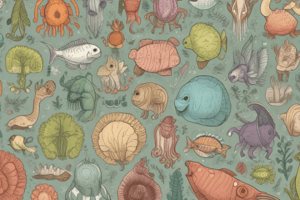Podcast
Questions and Answers
Which characteristic of life involves maintaining a constant internal environment?
Which characteristic of life involves maintaining a constant internal environment?
- Acquiring and using energy
- Sensing the environment
- Responding to external stimuli
- Maintaining homeostasis (correct)
What is the smallest unit of life contained within a plasma membrane?
What is the smallest unit of life contained within a plasma membrane?
- Tissue
- Organ
- Organism
- Cell (correct)
What is a cohesive group of similar cells performing a specific function called?
What is a cohesive group of similar cells performing a specific function called?
- Tissue (correct)
- Organism
- Organ
- Organ system
Which characteristic of life involves the ability to adapt to the environment?
Which characteristic of life involves the ability to adapt to the environment?
What is a structure composed of more than one tissue called?
What is a structure composed of more than one tissue called?
What is the science that deals with the study of all living things called?
What is the science that deals with the study of all living things called?
What is the broad biological function performed by a group of organs called?
What is the broad biological function performed by a group of organs called?
What is the meaning of homeostasis?
What is the meaning of homeostasis?
How is body warmth maintained in humans?
How is body warmth maintained in humans?
What is the natural hierarchy of biological organization?
What is the natural hierarchy of biological organization?
What is taxonomy in biology?
What is taxonomy in biology?
What does artificial classification in biology use to identify organisms?
What does artificial classification in biology use to identify organisms?
What does natural organization in biology emerge from?
What does natural organization in biology emerge from?
What is the purpose of taxonomy in biology?
What is the purpose of taxonomy in biology?
What is the smallest unit of life according to biological organization?
What is the smallest unit of life according to biological organization?
What are the broad biological function performed by a group of organ systems called?
What are the broad biological function performed by a group of organ systems called?
What is the meaning of 'homeostasis' in Greek?
What is the meaning of 'homeostasis' in Greek?
What does artificial classification in biology use to group organisms?
What does artificial classification in biology use to group organisms?
Humans are considerd as?
Humans are considerd as?
What is the correct order of taxonomy for modern humans?
What is the correct order of taxonomy for modern humans?
Which taxonomic level includes ONLY Homo sapiens (modern day humans)?
Which taxonomic level includes ONLY Homo sapiens (modern day humans)?
Flashcards
Homeostasis
Homeostasis
Maintaining a stable internal environment in an organism.
Cell
Cell
The smallest unit of life, enclosed by a membrane.
Tissue
Tissue
A group of similar cells working together.
Adaptation
Adaptation
Signup and view all the flashcards
Organ
Organ
Signup and view all the flashcards
Biology
Biology
Signup and view all the flashcards
Organ system
Organ system
Signup and view all the flashcards
Biological organization
Biological organization
Signup and view all the flashcards
Taxonomy
Taxonomy
Signup and view all the flashcards
Artificial Classification
Artificial Classification
Signup and view all the flashcards
Natural Classification
Natural Classification
Signup and view all the flashcards
Human Body Temperature Maintenance
Human Body Temperature Maintenance
Signup and view all the flashcards
Eukarya
Eukarya
Signup and view all the flashcards
Modern Human Taxonomy
Modern Human Taxonomy
Signup and view all the flashcards
Homo sapiens
Homo sapiens
Signup and view all the flashcards
Organism
Organism
Signup and view all the flashcards
Species
Species
Signup and view all the flashcards
Study Notes
Characteristics of Life
- Homeostasis involves maintaining a constant internal environment
- Adaptation involves the ability to adapt to the environment
Levels of Organization
- The smallest unit of life is a cell, contained within a plasma membrane
- A group of similar cells performing a specific function is called tissue
- A structure composed of more than one tissue is called an organ
- A group of organs performing a broad biological function is called an organ system
- The natural hierarchy of biological organization is: cell → tissue → organ → organ system
Taxonomy and Classification
- Taxonomy is the science that deals with the study of all living things
- Artificial classification in biology uses characteristics to identify and group organisms
- Natural organization in biology emerges from evolutionary relationships
- The purpose of taxonomy in biology is to understand and classify living organisms
- Humans are considered as Homo sapiens
- The correct order of taxonomy for modern humans is: Domain: Eukarya, Kingdom: Animalia, Phylum: Chordata, Class: Mammalia, Order: Primates, Family: Hominidae, Genus: Homo, Species: Homo sapiens
- The taxonomic level that includes ONLY Homo sapiens (modern day humans) is Species
Homeostasis
- Homeostasis is the maintenance of a constant internal environment
- In humans, body warmth is maintained through homeostasis
- The meaning of 'homeostasis' in Greek is "remaining the same"
Studying That Suits You
Use AI to generate personalized quizzes and flashcards to suit your learning preferences.




